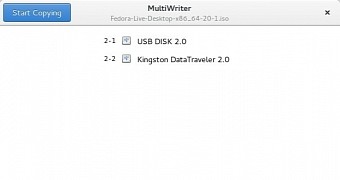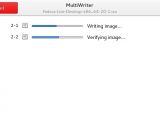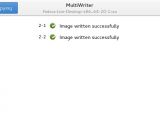The GNOME stack is getting all kind of interesting apps and now a new one is in the making, called the GNOME MultiWriter. This app is capable of writing an ISO to multiple devices at once and it's doing it with a simple and clear interface.
Some of the Linux aficionados will never let go of the dd utility, despite it being quite risky to use. When it comes to writing ISOs on USB sticks and other devices, there are not too many options out there. That might seem strange, but there wasn't any real need for this kind of apps, not even front end for the existing command line utilities.
GNOME Disks can also write ISOs by using the "Restore Disk Image" option, but that creates a number of problems with the partition table of the device that can be corrected only with Gparted. So, a GNOME developer decided to make an application that could do all that for regular users. This tool was born out of necessity and it will fit just fine in the GNOME stack.
GNOME MultiWriter is simple and easy to use
This is just the first version of the application, so there are probably a few problems with it. As you can see, it carries the 3.15.1 version number and that means that it's still under development. It's likely that it will be included in the 3.16 release, but that's not a certainty.
"I spent last night writing a GNOME application to duplicate a ton of USB devices. I looked at mdcp, Clonezilla and also just writing something loopy in bash, but I need something simple my dad could use for a couple of hours a week without help. It’s going to be super useful for me when I start sending our LiveUSB disks in the ColorHug box (rather than LiveCDs) and possibly useful to other people just wanting to copy a USB drive for QA testing on a small group of people," wrote GNOME developer Richard Hughes.
For now, only the source package are available and you can download it from Softpedia. If you are using Ubuntu, then you will need the following packages installed first: gnome-common, yelp-tools, libudisks2-dev, gobject-introspection, and libcanberra-gtk3-dev.
Download the source package and run this commands:
make
sudo make install

 14 DAY TRIAL //
14 DAY TRIAL // 



